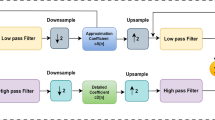Abstract
In diagnosis of brain death for human organ transplant, EEG (electroencephalogram) must be flat to conclude the patient’s brain death but it has been reported that the flat EEG test is sometimes difficult due to artifacts such as the contamination from the power supply and ECG (electrocardiogram, the signal from the heartbeat). ICA (independent component analysis) is an effective signal processing method that can separate such artifacts from the EEG signals. Applying ICA to EEG channels, we obtain several separated components among which some correspond to the brain activities while others contain artifacts. This paper aims at automatic selection of the separated components based on time series analysis. In the flat EEG test in brain death diagnosis, such automatic component selection is helpful.









Similar content being viewed by others
References
Amari S, Cichocki A, Yang HH (1996) A new learning algorithm for blind signal separation. In: Advances in neural information processing systems, vol 8. The MIT Press, pp 757–763
Cao J (2006) Analysis of the quasi-brain-death EEG data based on a robust ICA approach. Lect Notes Comput Sci 4253:1240–1247
Cao J, Chen Z (2008) Advanced EEG signal processing in brain death diagnosis. In: Signal processing techniques for knowledge extraction and information fusion. Springer, pp 275–298
Chen Z, Cao J, Cao Y, Zhang Y, Gu F, Zhu G, Hong Z, Wang B, Cichocki A (2008) An empirical EEG analysis in brain death diagnosis for adults. Cogn Neurodyn 2(3):257–271
Gallez D, Babloyantz A (1991) Predictability of human EEG: a dynamic approach. Biol Cybern 64(5):381–391
Hori G, Amari S, Cichocki A, Mizuno Y, Okuma Y, Aihara K (2000) Using ICA of EEG for judgment of brain death. In: Proceedings of international conference on neural information processing, pp 1216–1219
Hori G, Aihara K, Mizuno Y, Okuma Y (2001) Blind source separation and chaotic analysis of EEG for judgment of brain death. Artif Life Robot 5(1):10–14
Ikeguchi T, Aihara K, Itoh S, Utsunomiya T (1990) An analysis on the Lyapunov spectrum of electroencephalographic (EEG) potentials. Trans IEICE E73(6):842–847
Kaplan DT, Glass L (1983) Coarse-grained embeddings of time series: random walks, Gaussian random processes, and deterministic chaos. Phys D 64(4):431–454
Lee TW, Girolami M, Sejnowski TJ (1999) Independent component analysis using an extended infomax algorithm for mixed sub-Gaussian and super-Gaussian sources. Neural Comput 11(2):417–441
Sugihara G, May RM (1990) Nonlinear forecasting as a way of distinguishing chaos from measurement error in time series. Nature 344(19):734–741
Takens F (1981) Detecting strange attractors in turbulence. In: Dynamical system and turbulence. Lecture Notes in Mathematics, vol 898. Springer, pp 366–381
Taylor RM (1997) Reexamining the definition and criteria of death. Semin Neurol 17(3):265–270
Wayland R, Bromley D, Pickett D, Passamante A (1993) Recognizing determinism in a time series. Phys Rev Lett 70(5):580–582
Wijdicks EFM (1995) Determining brain death in adults. Neurology 45:1003–1011
Wijdicks EFM (2002) Brain death worldwide: accepted fact but no global consensus in diagnostic criteria. Neurology 58:20–25
Acknowledgments
The authors would like to thank Dr. Zhen Hong, Dr. Guoxian Zhu and Dr. Yue Zhang of the Shanghai Huashan Hospital and Prof. Yang Cao and Prof. Fanji Gu of the Fudan University for the EEG experiments. This work was supported in part by KAKENHI (22560425).
Author information
Authors and Affiliations
Corresponding author
Rights and permissions
About this article
Cite this article
Hori, G., Cao, J. Selecting EEG components using time series analysis in brain death diagnosis. Cogn Neurodyn 5, 311–319 (2011). https://doi.org/10.1007/s11571-010-9149-2
Received:
Revised:
Accepted:
Published:
Issue Date:
DOI: https://doi.org/10.1007/s11571-010-9149-2




